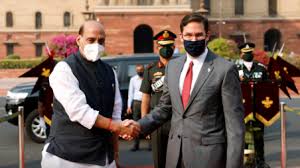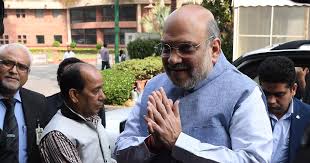Feature
Economic Survey says double-digit growth possible, inflation easing

New Delhi: India’s Economic Survey has projected growth at over 8 percent for the next fiscal and said inflation was easing while setting the agenda for “big-bang” reforms to further drive expansion, prune wasteful expenditure and promote investments in a green way.
Tabled in parliament Friday by Finance Minister Arun Jaitley and authored by a team led by Chief Economic Advisor Arvind Subramanian, the annual report card on the state of the economy said the growth should now rise further and double digit expansion was a possibility.
But it also had a caveat. “The growth estimates of over 8 percent for the year is on expectations that the monsoon will be favourable, as it was forecast to be normal, compared to last year,” it said, adding that such an expansion was necessary to address poverty.
“Double-digit growth can help in ‘wiping every tear from every eye’ and realising the aspirations of India’s youth,” the survey said, indicating this should also be an easier task for the government now with a clear political mandate for reform and a benign external environment.
“Decisive shifts in policies controlled by the Centre combined with a persistent, encompassing, and creative incrementalism in other areas could cumulate to ‘Big Bang’ reforms.”
It said Gross Domestic Product (GDP) growth in 2012-13 was 5.1 percent, which increased to 6.9 percent in 2013-14 and was now expected to further increase to 7.4 percent in 2014-15, as per advance estimates available with the government.
On the intended green actions, the survey said while the shift from a carbon subsidisation regime to one of taxation and from negative pricing on emissions to putting an implicit positive price was welcome, there was still a long way to go on reform of coal and petroleum pricing.
On inflation, the survey said, there has been a fall of over 6 percentage points since 2013, even as the external sector, which includes exports and inflow of foreign funds, was returning to a path of strength and resilience. Industrial growth has also picked up now.
It also had some good news to report on the farm sector. “Foodgrain production for 2014-15 is estimated at 257.07 million tonnes and will exceed that of last year by 8.5 million tonnes.”
It also called for three incremental steps to create a national national market for farm produce: Removing fruits and vegetables from list of regulated goods, policy support from states to create alternative or special markets in private sector, and liberal policy for foreign investment.
The survey noted with concern the fall in productive investment in India in recent years. It said investment rate over the past years, as measured by gross capital formation (GCF) as a percentage of GDP declined from 38.2 percent in 2011-12 to 32.3 percent in 2013-14.
It also made a case for rationalisation of subsidies and said such doles did not appear to have had a transformative effect on the living standards of the poor. On the fiscal side, it said the government was committed to consolidation with revenue generation a priority.
The survey said a close look at price subsidies, which are estimated at around Rs.3,78,000 crore, or 4.24 percent of GDP, reveal that they may not be the government’s best weapon for fighting poverty.
Importantly, it also observed that the current subsidy regime indicates that rich households benefited more from such doles than the poor. Among various examples it dwelt upon for this conclusion, it said that subsidy on electricity can only benefit the relatively rich.
At the same time, the survey said, eliminating or phasing out subsidies was “neither feasible nor desirable” and said the “JAM” trinity — Jan Dhan Yojana, Aadhar cards and mobile phones — will allow the government to deliver such doles in a targeted and less-distorted manner.
The survey also dwelt on Prime Minister Narendra Modi’s pet project “Make in India” and said this key policy objective can be achieved by deciding what to make, giving priority to services and making some structural transformation in the skill sets of the labour force.
Equally important, it noted, was the removal of distortions that were preventing manufacturing to become an engine of economic growth, such as those in labour markets, capital markets, the land market and lack of sync between need for skilling and comparative advantage of labour force.
Entertainment
Meghalaya Reserves Legalized Gambling and Sports Betting for Tourists

The State Scores Extra High on Gaming-Friendly Industry Index
Meghalaya scored 92.85 out of 100 possible points in a Gaming Industry Index and proved to be India’s most gaming-friendly state following its recent profound legislation changes over the field allowing land-based and online gaming, including games of chance, under a licensing regime.
The index by the UK India Business Council (UKIBC) uses a scale of 0 to 100 to measure the level of legalisation on gambling and betting achieved by a state based on the scores over a set of seven different games – lottery, horse racing, betting on sports, poker, rummy, casino and fantasy sports
Starting from February last year, Meghalaya became the third state in India’s northeast to legalise gambling and betting after Sikkim and Nagaland. After consultations with the UKIBC, the state proceeded with the adoption of the Meghalaya Regulation of Gaming Act, 2021 and the nullification of the Meghalaya Prevention of Gambling Act, 1970. Subsequently in December, the Meghalaya Regulation of Gaming Rules, 2021 were notified and came into force.
All for the Tourists
The move to legalise and license various forms of offline and online betting and gambling in Meghalaya is aimed at boosting tourism and creating jobs, and altogether raising taxation revenues for the northeastern state. At the same time, the opportunities to bet and gamble legally will be reserved only for tourists and visitors.
“We came out with a Gaming Act and subsequently framed the Regulation of Gaming Rules, 2021. The government will accordingly issue licenses to operate games of skill and chance, both online and offline,” said James P. K. Sangma, Meghalaya State Law and Taxation Minister speaking in the capital city of Shillong. “But the legalized gambling and gaming will only be for tourists and not residents of Meghalaya,” he continued.
To be allowed to play, tourists and people visiting the state for work or business purposes will have to prove their non-resident status by presenting appropriate documents, in a process similar to a bank KYC (Know Your Customer) procedure.
Meghalaya Reaches Out to a Vast Market
With 140 millions of people in India estimated to bet regularly on sports, and a total of 370 million desi bettors around prominent sporting events, as per data from one of the latest reports by Esse N Videri, Meghalaya is set to reach out and take a piece of a vast market.
Estimates on the financial value of India’s sports betting market, combined across all types of offline channels and online sports and cricket predictions and betting platforms, speak about amounts between $130 and $150 billion (roughly between ₹9.7 and ₹11.5 lakh crore).
Andhra Pradesh, Telangana and Delhi are shown to deliver the highest number of bettors and Meghalaya can count on substantial tourists flow from their betting circles. The sports betting communities of Karnataka, Maharashtra, Uttar Pradesh and Haryana are also not to be underestimated.
Among the sports, cricket is most popular, registering 68 percent of the total bet count analyzed by Esse N Videri. Football takes second position with 11 percent of the bets, followed by betting on FIFA at 7 percent and on eCricket at 5 percent. The last position in the Top 5 of popular sports for betting in India is taken by tennis with 3 percent of the bet count.
Local Citizens will Still have Their Teer Betting
Meghalaya residents will still be permitted to participate in teer betting over arrow-shooting results. Teer is a traditional method of gambling, somewhat similar to a lottery draw, and held under the rules of the Meghalaya Regulation of the Game of Arrow Shooting and the Sale of Teer Tickets Act, 2018.
Teer includes bettors wagering on the number of arrows that reach the target which is placed about 50 meters away from a team of 20 archers positioned in a semicircle.
The archers shoot volleys of arrows at the target for ten minutes, and players place their bets choosing a number between 0 and 99 trying to guess the last two digits of the number of arrows that successfully pierce the target.
If, for example, the number of hits is 256, anyone who has bet on 56 wins an amount eight times bigger than their wager.























